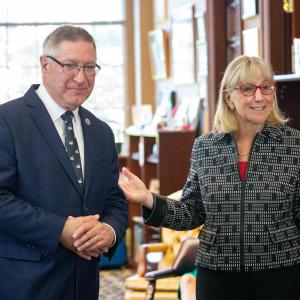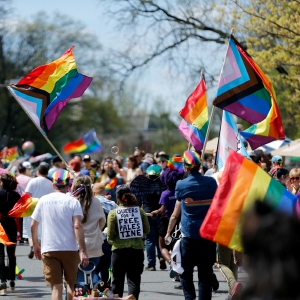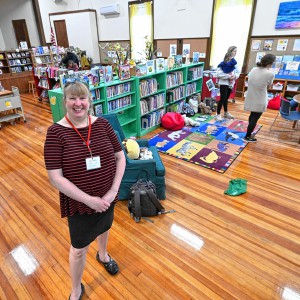KlezCummington celebrates Jewish culture, identity with weekend of music, art, food and more
| Published: 07-11-2023 12:11 PM |
CUMMINGTON — Tucked away along a hilly gravel road, shrouded by trees is a 14-acre property in rural Cummington stewarded by Northampton Judaica artist Emmett Leader.
For the past 15 years, Leader, who is also a sculptor, builder and baker, has slowly breathed new life into the parcel, restoring a 100-year-old barn and transforming the rundown property into a gathering space.
The tranquil space spawned a homegrown summertime festival dedicated to Yiddishkayt, or a Jewish way of life, through musical performances, dance, art and baking, along with Yiddish language, performance and song workshops.
This past weekend, the property played host for the third iteration KlezCummington festival, attracting people from just up the road as well as those from Montreal, New York, Boston and Philadelphia to western Massachusetts in celebration of culture and connection.
“We’ve come together from all these disparate places and we arrive as individuals, and if the Havdole (ritual at the close of the festival weekend) works, we leave together as one community,” said Ozzy Gold-Shapiro, one of five co-founders and lead directors of the annual event.
On Saturday, the fragrant blend of garlic, onions and other spices wafted through the air as attendees helped to shape dozens upon dozens of Montreal-style bagels that were poached in honey water and then baked in a wood-fired oven manned by Leader. The oven was built by Leader and several other community members.
Meanwhile, a group of more than 20 Klezmorim, or Jewish musicians playing klezmer, gathered for a a slow jam session in a tent nearby. The distinctive musical style, with its roots in Eastern Europe, is predominantly played for events such as weddings or b’nai mitzvahs. Other notable klezmer-related events include KlezKanada, which takes place outside of Montreal in August, and Yiddish New York, which will be held in New York City in December this year. Meanwhile, across the river in Amherst, the Yiddish Book Center was gearing up to host Yidstock 2023, now in its 11th year, this coming weekend, July 13-16.
In Cummington, as in Amherst, the focus goes beyond music to culture — although KlezCummington emphasizes inclusivity of more marginalized community members.
Article continues after...
Yesterday's Most Read Articles
“What we’re doing is quite unique,” said Leader’s daughter and fellow co-founder Rachel Leader.
“What we’re doing has been a natural and organic and authentic and meaningful outgrowth of so much community building, artistic growth and love. We really want to find ways to showcase and uplift the people who are keeping this culture alive and vibrant, especially showcasing the works and contributions of local trans, queer and women artists.”
Inside the barn was an art display created by Emmett Leader. The installation, called “Slonim Revisited,” provides a window into the world of Judaism and the Jewish Diaspora, he said.
Using a wooden shelter with earthenware panels on the walls, a large pair of doors, clay ritual objects integrated into the barn wall pedestals and various clay and found items on mantles, his work weaves two stories: one dealing with his youth in rural Vermont, and the other based upon the pre-World War II Eastern European Jewish shtetls of his grandparents and their ancestors.
Nearby, Gold-Shapiro led an outdoor workshop about where Jewish food comes from and an exploration of how diaspora, borders, immigration and more influenced what and how food is served. As part of that workshop, named “Ozzy’s Ashkenazi Kitchen,” attendees were directed by co-founder and lead chef Ariel Shapiro through the processes of making pickles as well as pickled beets and turnips, delegating duties of chopping radishes, turnips and garlic, and combining ingredients over a stovetop.
Once the food was cooked, attendees joined together in a communal lunch.
Emmett Leader said that holding such an event with so many people on land that he cherishes is about as “good as it gets.”
The event was first held in 2021 following challenges of isolation during the COVID-19 pandemic.
“There was such a desire to come together, to find joy and celebration, connection and community, and just to create something,” said Rachael Leader. “I couldn’t believe my eyes at the first festival. In contrast to the feeling of isolation and removedness from community and specifically the Jewish community, it was a mirage, truly a mirage seeing everyone here for the first time.”
For Rachel Leader, a native of Northampton, she didn’t feel connected to her cultural heritage until she discovered klezmer. Oftentimes, she says, she felt like the only way to “be Jewish” was by attending synagogue or learning more about religious aspects.
“I found a more sincere sense of belonging in a community that really centers music and art and that’s something that I found in klezmer and Yiddishkayt community,” she said.
Rachel Leader also performs in a band with fellow co-founders Gold-Shapiro, Shapiro and Clarissa Lyons in the klezmer band Burikes.
Similarly, Gold-Shapiro, who attended high school with Rachael Leader, said they also struggled with connection to their culture early on. After their b’nai mitzvah, Gold-Shapiro was convinced they were done with Jewish culture and had no intention of ever stepping foot into the Congregation B’nai Israel in Northampton again.
“Spoiler alert: I work there,” they said.
Gold-Shapiro started studying Yiddish in college roughly a decade ago and reconnected with Rachel Leader by playing music together. They discovered Yiddish around the time their grandfather started to lose his memory. Learning the first language that their grandfather spoke allowed them to have a connection they wouldn’t have experienced without that knowledge.
Gold-Shapiro also noted that Yiddish also provided a home for them as a queer and trans person.
“Yiddish was the first place where I actually felt comfortable expressing my full self. I found there were a lot more ways I could speak about myself in Yiddish before I even found the words in English. And the folks that are drawn to Yiddish … so many of us are queer, so many of us are trans. There are so many non-binary folks and folks who have felt excluded for a number of other reasons from a more mainstream Jewish community,” they said. “And we all found each other in this world. So I felt in many ways, like Yiddish was a homecoming.”

 State Senate budget funds free community college for all
State Senate budget funds free community college for all ‘We can just be who we are’: Thousands show support for LGBTQ community at Hampshire Pride
‘We can just be who we are’: Thousands show support for LGBTQ community at Hampshire Pride Doors open at Tilton Library’s temporary home at South Deerfield Congregational Church
Doors open at Tilton Library’s temporary home at South Deerfield Congregational Church Area property deed transfers, May 2
Area property deed transfers, May 2
